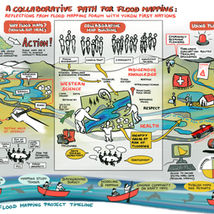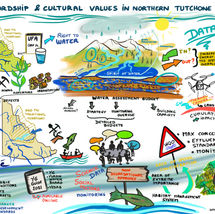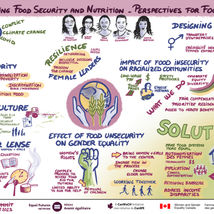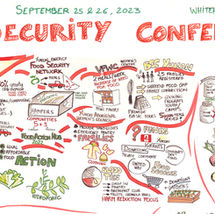Southern Lakes community-based salmon planning (2020)
A sociological, cultural, and scientific conversation between three Yukon First Nations regarding management of a precious resource, the Yukon River Chinook Salmon.
A project led by Dennis Zimmermann.
Project format: outdoor, in-person graphic recording. Large paper sheets setup on easel as no large walls were available.

Examples of graphic recording projects
How much does graphic recording cost?
My rate for graphic recording 1200 CAD per day or 600 CAD per half day (plus GST if applicable). This base rate includes materials, set up and take down on the event day, and the delivery of the graphic recording notes in digital format (including basic editing for typos and formatting).
Preparation is essential to make the most of graphic recording during the event. If a project requires significant preparation time (reading of background reports or articles, reviewing past presentations), I may budget a few hours of work in addition to the day rate. Similarly, some projects may require extra hours to be budgeted to conduct post-event work such as translations of the graphic recording notes, formatting changes, or design of new visuals.
When applicable, project management fees including virtual, phone or in-person meetings, as well as extensive email communications, are billed at a rate of 100 CAD/hour. Additional expenses such as printing, or travel time and expenses for events taking place outside of Whitehorse, Yukon, are added to the final invoice when applicable.
What kind of setup is required for graphic recording during a live event?

I can conduct graphic recording on large sheets of paper, or digitally on an iPad. Both methods have advantages depending on the context and setting of the event.
Paper graphic recording is very organic and more engaging for in person events. Participants will focus on the discussion happening in the room while the recording unfolds in front of their eyes. During coffee or lunch breaks, they will have opportunities to review the graphic recording notes, or to continue discussions with their peers using the illustrated notes as a reference. The paper sheets can be either taped to a wall, or attached to a system of rigid board and easels if no wall space is available. I can also work with smaller sheets using an easel for outdoor events. For hybrid or online events, a camera can be installed to film the graphic recording action, and shared with online participants.
Digital graphic recording (on iPad) is the method of choice for virtual-only events. In some context, it can be very suitable for an in-person event. I will share my screen through Zoom (or any other virtual event platform), either continuously or on-demand. For in person or hybrid event, I can also project the recording onto a screen in the room. One main advantage of digital recording over paper recording is the ability to prepare visuals ahead of time, as well as easily edit and modify the visual notes at the end of the event.
My event features multiple presentations taking place synchronously, and I want to record everything. Is it possible to hire several graphic recorders?
Yes! We do have a small network of graphic recorders in Whitehorse, and some of us have already worked together for past events, conducting simultaneous graphic recording, as well as providing a compiled synthesis after the event. Reach out for more information!

What if my event is postponed or cancelled after we have signed a work agreement?
If your event is postponed (and I am unable to accommodate the new date) or cancelled, or if you no longer require my services for your event, the following cancelation policy detailed in our work agreement will apply: there will be no cancellation charge if notice of the event or project cancellation occurs with at least 14 days’ notice. Cancellations with less than 14 days’ notice will be subject to cancellation charges as follows: (a) 25% of the total fee between 14-7 days’ notice, (b) 50% of the total fee between 7-1 days’ notice.
What do graphic recording deliverables look like?
For paper graphic recording, you will go home with the roll of paper containing all the graphic recording notes. I also take a picture of the paper recording and turn it into a digital file. I conduct basic photo editing to adjust the contrast, digitally remove the tape, and turn the visual recording into a file you may include in a report or website. For digital recording, I simply export an image (JPEG and PDF) of the graphic recording notes, after conducting all the necessary edits on the iPad.
In addition to the raw graphic recording notes collected during the event, a visual synthesis may be relevant to further synthesize and compile the most salient points of the discussion (this would be especially useful for multi-days meetings!). This synthesis is done digitally and usually formatted on a 11x17” sheet. The file resolution is high enough for the synthesis to be printed on a large poster if needed, or it can be simply included in a report or website, or shared with participants via email. Pricing for a visual synthesis ranges between 1500-2000 CAD depending on the amount of information to compile. This flat fee rate includes 3 rounds of revisions, delivery of a high-resolution digital file, as well as usage and license fees as detailed in the work agreement.
Can I use the images from the graphic recording and the visual synthesis however I want?
You are encouraged to reuse, print and display the graphic recording notes in your office space! It is the best way to keep your staff engaged and reminded about the discussion that just took place. Seeing the graphic recording notes will reactivate the visual memory of the event’s participants for days and months following the event. For those who were not present, reading the notes is an ideal way to get an engaging synthesis of the discussion.
Images created during a graphic recording session are the result of the combined work from the graphic recorder, and from the various participants who share ideas, research results, projects, etc... Both the visual work designed by the graphic recorder, and the ideas and concepts shared by participants, should be credited appropriately. The name of presenters, event organizers, or facilitators will be included on the graphic recording notes when applicable, and I will usually insert my logo or business name as well.
Graphic recording notes are a form of illustration, and therefore are subject to copyright rules. In a typical work agreement, clients will be granted non-exclusive, permanent, worldwide rights to use the images for non-commercial purposes. In practice, this means you will be able to share the images from the graphic recording in a wide range of contexts: websites, PowerPoint presentations, print and online reports, newsletters, etc. On my end, I will have the ability to share the recordings for self-promotional purpose, on my website or social media platforms.
Interested in a quote? Below is the information you will need to provide me:
General parameters about the event:
-
How many hours or days is the event, and how is it formatted (keynote presentations, breakout sessions, discussion…)?
-
Is the event taking place in-person, online, or hybrid?
-
If in person, where will the event take place? Does the venue have walls appropriate for graphic recording on paper, or should a different setup be considered?
-
How many people are attending and who is the audience (public, government, academics, technical group…)?
-
Is there a facilitator or anyone assisting with technical setup (for online events in particular)?
About the graphic recording, its purpose during the event and potential future uses:
-
Should the entire event be recorded or just specific sessions?
-
Is there documentation available about the project that can be shared with the graphic recorder prior to the event?
-
Do you anticipate wanting a final visual synthesis of the event in addition to recording the discussions during the event?
Contact me by email.
















